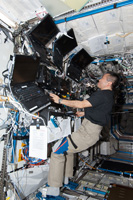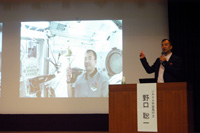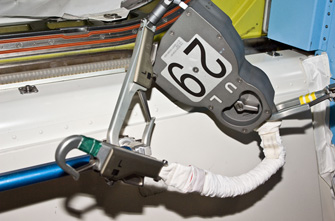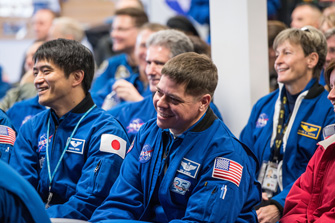Hello everyone. Thank you for keeping me company on Twitter the other day when I was waiting at the airport! Thanks to you all, my five-hour wait was very interesting! I hope we will have a chance to do that again in the future.
Well, in December, I had a longish holiday during which I had time to think about various things. I also had time to look back and reflect on my life. Today, I would like to talk about one of my experiences as I look back over my past. (I don’t know if it will be of much use to you but you will at least understand that I am not perfect.)
To be frank, I had various ups and downs before I became a test pilot for the Self-Defense Force. Life is strange as these all ended up being important in order for me to become an astronaut. The reason I went on to study at the National Defense Academy in the first place was not because I wanted to be a pilot or because I was aware of the importance of national defense. The real reason was that this was the only way that I could continue to with the studies that I loved so much and because of this, I had to give up my dreams of being an astronomer or an astronaut so it was an extremely hard decision for me to make at that time...
In this situation, I was fortunate enough to have been able to meet the requirements for becoming a pilot in the flight medical and psychological aptitude tests during my first year at the National Defense Academy. When I found out about this, I felt that it would be cool to become a pilot if I could so I started to show my interest in this. On the other hand, if I was going to be lucky enough to become a pilot, I wanted to fly cool fighter aircraft and, for this reason, I came to think that I wanted to join the Air Self-Defense Force.
However, there was absolutely no guarantee that I would be able to get into the Air Self-Defense Force. (In actual fact, when you start at the National Defense Academy, you are not assigned to one Self-Defense Force or another. This is decided in the 2nd year according to aptitude, the personnel required by each Self-Defense Force and the wishes of the person in question.) At any rate, there were many students who wanted to go on to be in the Air Self-Defense Force but it was the luck of the draw if they got their first choice. At that time, I heard rumors from older students that if you stood out in the 1st year class, you would definitely get your first choice. What was interesting about this rumor was that it was said that it didn’t matter if your results were the best in the class or the worst in the class.
When I looked into this further, it seemed like it was highly credible! 1st years at the National Defense Academy have, in a many different senses, a difficult time and they are busy but I really studied hard! (Lights out was at a set time but students who wanted to study more had to get permission and were allowed to study until midnight. I asked for permission to continue to study almost every day.)
I managed to become a member of the aviation personnel (a student who will join the Air Self-Defense Force in the future) and I had many different opportunities to participate in training. During the training in the summer of my 3rd year, a significant incident (?) occurred. The aim of this training was to fully understand the work of the Air Self-Defense Force and there was a training session with the fighter aircraft unit. At that time, we had the experience of boarding a small jet. I couldn’t tolerate the high g-forces and sadly, I fainted! I got off the plane with an ashen face... (If we suppose that the strength of gravity on the earth is 1g, this shows the greatness of the acceleration. For example, 2g is double the strength of gravity so your weight is also double. When you experience high g-forces, the blood in your body flows towards your feet and less blood flows to your brain. You lose consciousness if your brain doesn’t get enough oxygen by using special breathing methods or straining your body, etc.)
Consequently, I completely lost my confidence and began to look for another career path that did not involve being a pilot. I thought that I would like to study the sky so I started to work towards becoming an Air Self-Defense Force weather forecaster. I graduated from the National Defense Academy and went on to the Officer Candidate School of the Air Self-Defense Force. When I graduated from this school, there would be a final decision on my future job. When I took my final flight medical and was confirmed to have the physical aptitude to become a pilot, I wrote “weather” as my first choice rather than “pilot” and handed in my documents.
A few days later, my instructor called me in to his office.
Instructor: Why do you not want to be a pilot when you have the aptitude to be one?
I explained the story up to that point.
Instructor: Even though you have the opportunity, you are going to give up on it? That’s not the right thing to do! You have no idea whether you will really be able to become a pilot or not! You will still have the opportunity to choose weather if you don’t make pilot but your only chance to become a pilot is now!
I listened to him and thought it through carefully, then changed what I had written on my documents. I made a resolution to step up to the start line of the long, hard training to become a pilot by changing my first choice to “pilot”!
So, those of us who had chosen to work towards being pilots went on to the pilot training course! We start with training sessions other than those for flying. One of these was g-force resistance training. The training sessions are held in a capsule that artificially creates high g-forces using centrifugal force but, sadly, I fainted again during that training... I felt like I had failed at the first hurdle on the way to becoming a pilot...
Then, right after that training, the students, who were soon to be undergoing flight training, had the opportunity to be instructed by a very high up officer.
Officer: Is there anyone here who wants to be something other than a fighter pilot?
Three people, including myself, raised their hands. (Since I was unable to resist g-forces and kept passing out, I had been thinking about maybe working on transporters as they had nothing to do with high g-forces. And, more than that, ferrying people and equipment about was an important job!)
Officer: You three who put your hands up just now! I will not allow you to say that anymore! You must aim to be fighter pilots!
Me: (hmmm, this is going to be more difficult than I thought...)
From that moment onwards, I always wrote my first choice as “fighter pilot” on all documents.
Actual flight training started after that. I will tell you about that in more detail another time.
The training was hard and some of our fellow students did not make it and had to select a different career path...
The next big life choice was whether to take the course in which all education to become a pilot was conducted in Japan or the course of which a part was taught in the US. This decision is made after more than a year of continuous pilot training (this is how it was in my day ? it is a little different now). I chose the training in Japan and wrote this on my documents. I had two reasons for this.
1. I would become a pilot more quickly on the Japanese course as I wouldn’t have to study English.
2. If you took the overseas course, you had to go on to the fighter pilot course after you graduated.
On paper, my first choice was fighter pilot but, to be honest, in my heart, I still wanted to be a transporter pilot.
Finally, the day of the announcements for the Japanese and US groups came!
And I was faced with an unbelievable situation.
Instructor: Here are the names of those who will be in the US group. XX, YY, Yui! ? ...
Me: (What? It must be a mistake!)
After the announcement, I went straight to check with the instructor.
Me: Excuse me... I thought I had put down that I wanted to be in the Japanese group...
Instructor: Yes! Sorry! I re-wrote your form!
Me: (speechless)
Instructor: Don’t worry! You’ll be fine!
Me: (What are you basing that on?)
When I think about the fact that, up until then, I couldn’t speak English and that I encountered that film that would change my life in the US, the decision of this instructor has huge significance in my becoming an astronaut, although I had no way of knowing this at that time... (to be continued)
I hope you understood the extent of my indecisiveness. In part 2, I start to change!
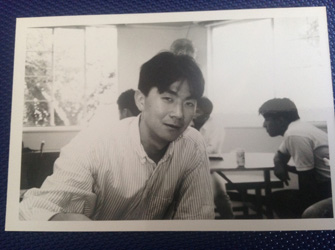
This is me when I was worrying about my career path... over 20 years ago.
*Photo: JAXA



